Most California parking laws and rules are regulated at a local level, so every city is a little bit different. However, this guide covers general parking laws in California.
Laws For Parking On A Hill In California
When you park:
- On a sloping driveway, turn the wheels so the vehicle will not roll into the street if the brakes fail.
- Headed downhill, turn your front wheels into the curb or toward the side of the road. Set the parking brake.
- Headed uphill, turn your front wheels away from the curb and let your vehicle roll back a few inches. The wheel should gently touch the curb. Set the parking brake.
- Headed either uphill or downhill when there is no curb, turn the wheels so the vehicle will roll away from the center of the road if the brakes fail.
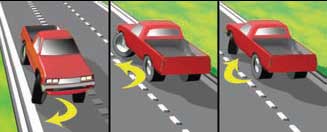
Down Hill Up Hill No Curb, Up Hill or Down Hill
Always set your parking brake and leave the vehicle in gear or in the “park” position.
Parallel Parking Laws In California
How to parallel park safely:
- Find a space. Look for a space at least 3 feet longer than your vehicle to safely park in the space without striking another vehicle or object. When you find a space, signal your intention to park.
- Pull your vehicle alongside the vehicle in front of your space, if any, 2 feet away from it and bumpers aligned. Check your rearview mirror and look over your shoulder for approaching vehicles. You can brake gently so approaching vehicles behind you will see the brake lights and stop to allow you to park. Keep your foot on the brake and put the vehicle in reverse. Maintain the turn signal.
- Lift your foot off the brake. Check your mirrors and look over your shoulder to make sure the street is clear of traffic before you begin to back up. Look over your shoulder at the space to make sure it is clear of any objects, pedestrians, animals, etc. Begin to back up while turning the wheel hard toward the curb; you want the angle to be sharp but not too sharp.
- Once the back of your seat is aligned with the rear bumper of the vehicle in front of the empty space, begin turning the steering wheel away from the curb.
- Straighten out. Your vehicle should now be about 6 inches from and parallel the curb. You might have to adjust your vehicle forward or backward before you put your vehicle in park and turn off the engine. Check your mirrors and look over your left shoulder for oncoming traffic or bicyclists before you exit.
How to Parallel Park Properly
Step 1
Bring your car to a stop alongside the car at the front of the space.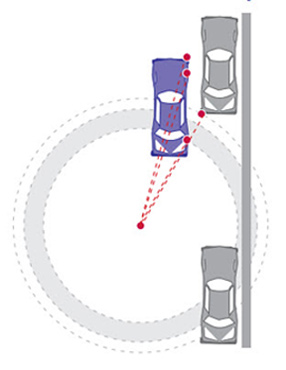
Step 2
Reverse into the space with an S motion.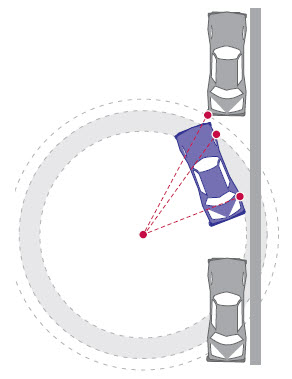
Step 3
Once the car is parallel with the curb, pull forward to center your car within the space.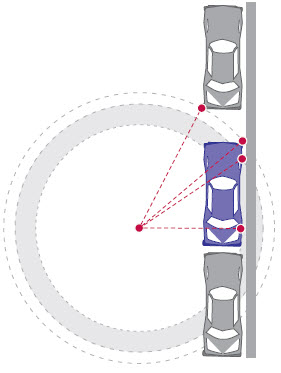
Parking At Colored Curbs In California
Painted colored curbs have the following special parking rules:
White–Stop only long enough to pick up or drop off passengers or mail.
Green–Park for a limited time. Look for a posted sign next to the green zone for time limits, or locate the time limit painted on the curb.
Yellow–Stop no longer than the time posted to load or unload passengers or freight. Drivers of noncommercial vehicles are usually required to stay with the vehicle.
Red–No stopping, standing, or parking. (Buses may stop at a red zone marked for buses.)
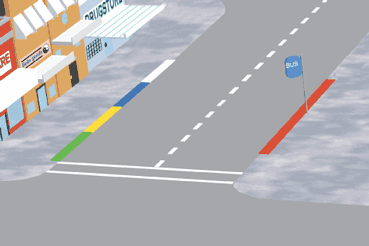
Blue–Parking is permitted only for a disabled person or a driver of a disabled person who displays a placard or a special license plate for disabled persons or disabled veterans. Disabled people with a placard or special plates may park in special areas for unlimited periods of time, regardless of time restrictions. No one other than a disabled person or a driver of a disabled person may park there. A crosshatched (diagonal lines) area adjacent to a designated disabled parking space is a no parking area. Qualified persons may apply at any DMV office or visit the DMV website atwww.dmv.ca.gov to obtain a form for a parking placard or special plates. An identification card will be issued to holders of disabled person or disabled veteran license plates.
Example of crosshatched (diagonal lines) area 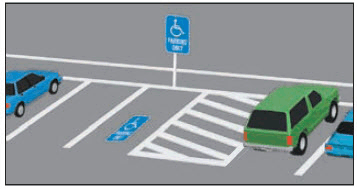
NOTE:Placard abuse results in the loss of special parking privileges. It is also a misdemeanor and punishable by a fine of up to $1,000, imprisonment in county jail for up to six months, or both.
Examples of placard abuse:
- Using a placard after it has been reported lost or stolen without reporting that the placard was found.
- Loaning your placard to friends or family members (disabled or not).
- Interchanging placards with friends or family members.
- Using a placard when the person it was issued to is not in the vehicle with you (disabled child, family member, disabled employer, etc.).
- Using a deceased person’s placard.
NOTE: Disabled plates and/or a placard must be surrendered or returned to the nearest DMV within 60 days of the death of the disabled person. The plates and/or placard can also be mailed to the following address:
DMV
PO Box 942869 MS D238
Sacramento, CA 94269-0001
Illegal Parking In California
Never park or leave your vehicle:
- Where a “No Parking” sign is posted.
- On a marked or unmarked crosswalk, sidewalk, partially blocking a sidewalk, or in front of a driveway.
- Within 3 feet of a sidewalk ramp for disabled persons or in front of or on a curb that provides wheelchair access to a sidewalk.
- In a disabled person parking space, unless you are disabled and display a placard or special plates.
- In the space next to a disabled person parking space, if it is painted in a crosshatched (diagonal) pattern (CVC §22507.8(c)(2)).
- In a space designated for parking or fueling zero-emission vehicles which display an identifying decal.
- In a tunnel or on a bridge, except where permitted by signs.
- Within 15 feet of a fire hydrant or a fire station driveway.
- On or within 7½ feet of a railroad track.
- Between a safety zone and the curb.
- “Double parked.” (Parking in the street when all legal parking places at the curb are taken.)
- On the wrong side of the street.
- At a red curb.
- On a freeway, except:
- In an emergency, or
- When an officer or device requires a stop, or
- Where a stop is specifically permitted. A vehicle (even if disabled) that is stopped, parked, or left standing on a freeway for more than four hours may be removed (CVC §22651(f)).
NOTE: If you must stop on a freeway, park completely off the pavement and stay in your vehicle with the doors locked until help arrives. Leave enough space for other vehicles to freely pass by your vehicle. Your vehicle should be visible for at least 200 feet in each direction.
Special Parking Rules In California
- When you park alongside a curb on a level street, the front and back wheels must be parallel and within 18 inches of the curb. Park parallel to the street if there is no curb.
- Never leave your vehicle while the engine is still running; stop the engine and set the parking brake.
- When you are ready to exit your vehicle, look carefully for passing vehicles, bicyclists, and motorcyclists. Do not open the driver’s side door unless it is safe to do so and you do not interfere with traffic. Do not leave the door open any longer than necessary.
